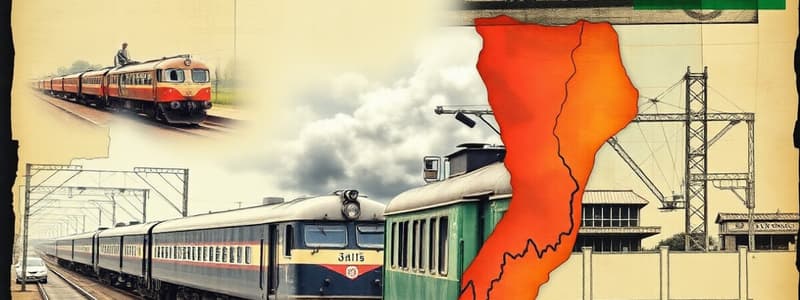Podcast
Questions and Answers
Which type of siding is specifically constructed to serve a Government Department or an industrial unit under a special arrangement?
Which type of siding is specifically constructed to serve a Government Department or an industrial unit under a special arrangement?
- Public siding
- Colliery siding
- Assisted siding (correct)
- Military siding
What is the primary role of railway sidings in relation to the Indian Railways?
What is the primary role of railway sidings in relation to the Indian Railways?
- To facilitate the delivery and collection of various traffic types (correct)
- To provide accommodation for railway workers
- To generate revenue through passenger tickets
- To serve as collection points for freight taxes
Which of the following railway sections is part of the Khurda Road Division operating controls?
Which of the following railway sections is part of the Khurda Road Division operating controls?
- Bhopal Control
- Jammu Control
- Paradeep Control (correct)
- Delhi Control
What is the purpose of the FOIS in the Indian Railways system?
What is the purpose of the FOIS in the Indian Railways system?
What type of rake is associated with container transportation in Indian Railways?
What type of rake is associated with container transportation in Indian Railways?
Which of the following represents a type of siding used exclusively for military purposes?
Which of the following represents a type of siding used exclusively for military purposes?
What is the significance of demurrage charges in the railway freight process?
What is the significance of demurrage charges in the railway freight process?
Which process is involved in generating the Rake Release (RR) in the context of railway operations?
Which process is involved in generating the Rake Release (RR) in the context of railway operations?
What is the maximum carrying capacity for the BOBR wagon with a tolerance of CC+8?
What is the maximum carrying capacity for the BOBR wagon with a tolerance of CC+8?
Which wagon type has the lowest tare weight listed?
Which wagon type has the lowest tare weight listed?
For a BOBS wagon with a CC+6 tolerance, what is its carrying capacity?
For a BOBS wagon with a CC+6 tolerance, what is its carrying capacity?
What is the difference in maximum carrying capacity between BOBRM1 at CC+4 and BOBRN, BOBRNHS/BOBR at CC+4?
What is the difference in maximum carrying capacity between BOBRM1 at CC+4 and BOBRN, BOBRNHS/BOBR at CC+4?
What is the carrying capacity of the BOBS wagon at CC+8 tolerance?
What is the carrying capacity of the BOBS wagon at CC+8 tolerance?
Which wagon has the highest carrying capacity at CC+6 tolerance for steel?
Which wagon has the highest carrying capacity at CC+6 tolerance for steel?
What is the carrying capacity of a BOBSNM1 at CC+8?
What is the carrying capacity of a BOBSNM1 at CC+8?
Among the listed wagons, which type has a carrying capacity of 63.50 at all tolerances for G.Slag?
Among the listed wagons, which type has a carrying capacity of 63.50 at all tolerances for G.Slag?
What is the additional surcharge applicable on Container Rakes starting from October 1, 2023?
What is the additional surcharge applicable on Container Rakes starting from October 1, 2023?
How long is the free time for a BOBRN Rake?
How long is the free time for a BOBRN Rake?
What is the demurrage charge rate for the first 6 hours of detention?
What is the demurrage charge rate for the first 6 hours of detention?
How is the total demurrage charge calculated?
How is the total demurrage charge calculated?
What is the combined free time duration for a Steel Rake when EM PAD Change and BPC revalidation are applicable?
What is the combined free time duration for a Steel Rake when EM PAD Change and BPC revalidation are applicable?
What is the purpose of the POL charge in the given situations?
What is the purpose of the POL charge in the given situations?
During which season is the Development Surcharge increased to 15%?
During which season is the Development Surcharge increased to 15%?
What calculation is the Normal Tariff Rate (NTR) based on?
What calculation is the Normal Tariff Rate (NTR) based on?
What is the GPWIS Rebate percentage?
What is the GPWIS Rebate percentage?
What is the Permissible Carrying Capacity (PCC) indicated in the content?
What is the Permissible Carrying Capacity (PCC) indicated in the content?
Which of the following is a specific charge applied only to Private Freight Terminals (PFT)?
Which of the following is a specific charge applied only to Private Freight Terminals (PFT)?
What is the Dynamic Pricing for Commodities other than Coal & Coke during the Lean Season?
What is the Dynamic Pricing for Commodities other than Coal & Coke during the Lean Season?
What is the rate per unit as shown for outward GPWIS Rakes?
What is the rate per unit as shown for outward GPWIS Rakes?
What is the maximum carrying capacity (CC+8) for the BOXNHS wagon type when carrying Coke?
What is the maximum carrying capacity (CC+8) for the BOXNHS wagon type when carrying Coke?
Which wagon type has a carrying capacity (CC+4) of 20.41 tons with Fly Ash?
Which wagon type has a carrying capacity (CC+4) of 20.41 tons with Fly Ash?
For the BOXNCR wagon type, what is its carrying capacity (CC+6) with G.Slag?
For the BOXNCR wagon type, what is its carrying capacity (CC+6) with G.Slag?
Which of the following wagon types has the lowest carrying capacity (CC+8) when transporting Steel?
Which of the following wagon types has the lowest carrying capacity (CC+8) when transporting Steel?
What is the tare weight for the BOXNUG wagon type?
What is the tare weight for the BOXNUG wagon type?
Which wagon type has a G.Slag carrying capacity (CC+4) of 64.00 tons?
Which wagon type has a G.Slag carrying capacity (CC+4) of 64.00 tons?
At CC+4, what is the maximum capacity of the BOXNHL 25T wagon for Fly Ash?
At CC+4, what is the maximum capacity of the BOXNHL 25T wagon for Fly Ash?
Which of these wagon types has a carrying capacity (CC+6) value of 68.70 tons when carrying Coke?
Which of these wagon types has a carrying capacity (CC+6) value of 68.70 tons when carrying Coke?
What is the difference in carrying capacity (CC+8) between BOXNHA and BOXNHAM when carrying Fly Ash?
What is the difference in carrying capacity (CC+8) between BOXNHA and BOXNHAM when carrying Fly Ash?
Which wagon type has a carrying capacity (CC+6) of 66.00 tons when filled with Steel?
Which wagon type has a carrying capacity (CC+6) of 66.00 tons when filled with Steel?
Flashcards are hidden until you start studying
Study Notes
Indian Railway Zones
- Contains a map outlining the various zones of the Indian Railways
- Outlines the different zones of the Indian Railways
East Coast Railway Sections
- Contains a map outlining the various sections of the East Coast Railway
Khurda Road Division Controls
- The Khurda Road Division uses a system where control is split between six different locations: Talcher, Bhadrak, Kendujhar, Palasa, Khurda and Paradeep
Railway Sidings
- Railway sidings are an extension of the railway system
- Assisted/Private Sidings: are sidings constructed to serve industrial premises such as factories, and mills.
- Departmental Sidings: are used by railway departments
- Public Sidings: are owned by the railways and are available to the public
- Military Sidings: are used by the military
- Colliery Sidings: are used for coal mining
Tata Steel Ltd. Permissible Carrying Capacity
- Provides a table outlining permissible carrying capacities for various Tata Steel Ltd. Products
- Tolerance in weight is provided across different categories of weight in kg: CC+4, CC+6, CC+8 and 25T Axel, for the following products: Steel, G. Slag, Fly Ash and Coke.
- Hopper Wagons: Contains specific permissible carrying capacity for hopper wagons: BOBR, BOBRM1, BOBRN, BOBRNHS, BOBRNEL; BOBRNHSM2; BOBRM1, BOBRNAHSM1, BOBSN, BOBSNM1, BOBS, BOBX, BOBSNS
Carrying Capacity and Tare Weights of Wagons
- Outlines the permissible carrying capacity and tare weight of various wagons: BOXN, BOXNCR, BOXNCR, BOXNEL, MBOXN, BOXNUG, BOXNHS, BOXNHSM1, BOXNM1, BOXNHL, BOXNHL 25T, BOXNHA, BOXNHAM, BOXNLW, BOXNLWM1, BOXNR, BOXNRHS, BOXNRM2, BOXNG, BOXNS, BOST, BOSTM1, BOSTHS, BOSTHSM1, BOSTHSM2, BOSTHSM3
Punitive Charge for Overloading - Situation A & B
- Outlines specific punitive charges for overloading in two situations, A and B.
- Situation A: POL 1 - 2, POL 2 - 2.5
- Situation B: POL 1 - 3, POL 2 - 4
Freight Calculation of Outward GPWIS Rakes
- Provides a breakdown of outgoing freight calculation for GPWIS rakes
- Rate: DPCB - example rate 508.7
- PCC: Permissible Carrying Capacity - example 3828 T (58 BOXNHL Wgns)
- DS: Development Surcharge - 5%
- DPO: Dynamic Pricing for Commodities other than Coal & Coke
- Busy Season (Apr to June & Oct to Mar) - 15%
- Lean Season (July to Sep) - N/A
- NTR: Normal Tariff Rate - Base Rate + DPO
- DTC: Destination Terminal Charges - 20 (Private Freight Terminal)
Free Time of Rakes
- Inward Rakes:
- BOBRN Rake (Track Hopper) - 2 hours
- BOXN Rake (Tippler or manual unloading) - 5 hours
- Outward Rakes:
- Steel Rakes - 6 hours (extra 2 hours for EM PAD Change + 5 hours for BPC revalidation at TSLJ/JSPK/MBMB Railway Sidings)
- Slag Rakes - 3 hours
- Coal Tar Rakes - 5 hours
- Coke Rakes - 3 hours
- Fly Ash Rakes - 3 hours + 1 hour (Tarpaulin Covering)
Demurrage Charges Calculation
- Demurrage charges are applicable if the rolling stock is retained beyond the stipulated free time
- Formula: Total DC = DC Rate * Total no. of Loaded Wagons*DC Hour
- Charges vary by hours:
- Less Than or equal to 6 Hrs. - 150
- 7 to 12 Hrs. - 165
- 13-24 - 187.5
- 25-48 - 225
- 49-72 - 300
Studying That Suits You
Use AI to generate personalized quizzes and flashcards to suit your learning preferences.




